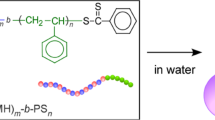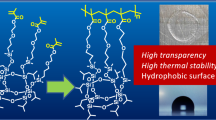Abstract
Lithium p-styrenesulfonate (LiSS) is a water-soluble monomer that exhibits good solubility compared with sodium p-styrenesulfonate (NaSS). Radical copolymerization of LiSS was investigated using acrylamide (AAm) as the comonomer in water at 60 °C in the presence of various salts as additives. The copolymerization of LiSS and AAm as highly reactive and less reactive monomers, respectively, provided a random copolymer consisting of a large amount of LiSS repeating unit at an earlier stage in the reaction. Then, the homopolymerizations of AAm spontaneously proceeded after LiSS was consumed at a high conversion (over 99%). A large amount of lithium chloride was added to the copolymerization system, promoting the polymerization reactivity of LiSS. The addition of lithium bromide and sodium bromide suppressed the copolymerization of LiSS and AAm and completely prevented the spontaneous homopolymerization of AAm after copolymerization. The effects of other additives on the copolymerization systems were investigated, and the combination of sodium nitrite and ascorbic acid was revealed to inhibit the copolymerization of LiSS and AAm. The interactions between lithium cations and functional groups in the monomers and polymers that benefit the copolymerization reactivity is discussed.
This is a preview of subscription content, access via your institution
Access options
Subscribe to this journal
Receive 12 print issues and online access
$259.00 per year
only $21.58 per issue
Buy this article
- Purchase on Springer Link
- Instant access to full article PDF
Prices may be subject to local taxes which are calculated during checkout





Similar content being viewed by others
References
Tian Q, Yu X, Zhang L, Yu D. Monodisperse raspberry-like multihollow polymer/Ag nanocomposite microspheres for rapid catalytic degradation of methylene blue. J Col Inter Sci. 2017;491:294–304.
Salunkhe B, Schuman TP. Super-adsorbent hydrogels for removal of methylene blue from aqueous solution: Dye adsorption isotherms, kinetics, and thermodynamic properties. Macromol. 2021;1:56–275.
Xing L, Guo N, Zhang Y, Zhang H, Liu J. A negatively charged loose nanofiltration membrane by blending with poly(sodium 4-styrene sulfonate) grafted SiO2 via SI-ATRP for dye purification. Sep Purif Technol. 2015;146:50–59.
Deboli F, Bruggen B, van der, Donten ML. A novel concept of hierarchical cation exchange membrane fabricated from commodity precursors through an easily scalable process. J Mem Sci 2021;636:119594.
Gadim TDO, Figueiredo AGPR, Rosero-Navarro NC, Vilela C, Gamelas JAF, Barros-Timmons A, et al. Nanostructured bacterial cellulose-poly(4-styrene sulfonic acid) composite membranes with high storage modulus and protonic conductivity. ACS Appl Mater Inter. 2014;6:7864–75.
Yamazaki M, Akiyama E, Ozoe S. Synthesis of poly(styrenesulfonate)-poly(dialkylacrylamide) block copolymers and preparation of conductive PEDOT composites. Kobunshi Ronbunshu. 2017;74:524–33.
Kayser LV, Lipomi DJ. Stretchable conductive polymers and composites based on PEDOT and PEDOT:PSS. Adv Mater. 2019;31:1806133.
Li S-S, Xie Y, Xiang T, Ma L, He C, Sun S-D, et al. Heparin-mimicking polyethersulfone membranes: Hemocompatibility, cytocompatibility, antifouling and antibacterial properties. J Mem Sci. 2016;498:135–46.
Amokrane G, Humblot V, Jubeli E, Yagoubi N, Ramtani S, Migonney V, et al. Electrospun poly(ε-caprolactone) fiber scaffolds functionalized by the covalent grafting of a bioactive polymer: Surface characterization and influence on in vitro biological response. ACS Omega. 2019;4:17194–208.
Luo F, Sun TL, Nakajima T, Kurokawa T, Zhao Y, Ihsan AB, et al. Crack blunting and advancing behaviors of tough and self-healing polyampholyte hydrogel. Macromolecules. 2014;47:6037–46.
He X, Zhang C, Wang M, Zhang Y, Liu L, Yang W. An electrically and mechanically autonomic self-healing hybrid hydrogel with tough and thermoplastic properties. ACS Appl Mater Inter. 2017;9:11134–43.
Rahman A, Solaiman, Foyez T, Susan ABHM, Imran AB. Self-healable and conductive double-network hydrogels with bioactive properties. Macromol Chem Phys. 2020;221:2000207.
Lu F, Li G, Yu Y, Gao X, Zheng L, Chen Z. Zwitterionic impetus on single lithium-ion conduction in solid polymer electrolyte for all-solid-state lithium-ion batteries. Chem Eng J. 2020;384:123237.
Li Z, Liu F, Chen S, Zhai F, Li Y, Feng Y, et al. Single Li ion conducting solid-state polymer electrolytes based on carbon quantum dots for Li-metal batteries. Nano Ener. 2021;82:105698.
Gao X, Guo C, Ma Z, Xi G, Meng Y, Li Y. Boosting Li-S battery performance using an in-cell electropolymerized conductive polymer. Mater Adv. 2021;2:974–84.
Bilgin S, Tomovska R, Asua JM. Effect of ionic monomer concentration on latex and film properties for surfactant-free high solids content polymer dispersions. Eur Polym J. 2017;93:480–94.
Bilgin S, Tomovska R, Asua JM. Surfactant-free high solids content polymer dispersions. Polymer. 2017;117:64–75.
Sharker KK, Ohara Y, Shigeta Y, Ozoe S, Yusa S. Upper critical solution temperature (UCST) behavior of polystyrene-based polyampholytes in aqueous solution. Polym (Basel). 2019;11:265.
Sharker KK, Shigeta Y, Ozoe S, Yusa S. Amphoteric statistical copolymers with well-controlled structure and upper critical solution temperature in aqueous solutions. Chem Lett. 2020;49:1443–6.
Sharker KK, Shigeta Y, Ozoe S, Damsongsang P, Hoven VP, Yusa S. Upper critical solution temperature behavior of pH-responsive amphoteric statistical copolymers in aqueous solutions. ACS Omega. 2021;6:9153–63.
Wang H, Fliedel C, Manoury E, Poli R. Core-crosslinked micelles with a poly-anionic poly(styrene sulfonate)-based outer shell made by RAFT polymerization. Polymer. 2022;243:124640.
Buback M, Hutchinson RA, Lacík I. Radical polymerization kinetics of water-soluble monomers. Prog Polym Sci. 2023;138:101645.
Martinez-Ibanez M, Sanchez-Diez E, Qiao L, Meabe L, Santiago A, Zhu H, et al. Weakly coordinating fluorine-free polysalt for single lithium-ion conductive solid polymer electrolytes. Bat Super. 2020;3:738–46.
Mengistie TS, Ko JM, Kim JY. Enhanced single-ion conduction and free-standing properties of solid polymer electrolyte by incorporating a polyelectrolyte. Mater Res Exp. 2021;8:035308.
Diederichsen KM, McShane EJ, McCloskey BD. Promising routes to a high Li+ transference number electrolyte for lithium ion batteries. ACS Energy Lett. 2017;2:2563–75.
Koda T, Dohi S, Tachi H, Suzuki Y, Kojima C, Matsumoto A. One-shot preparation of polyacrylamide/poly(sodium styrenesulfonate) double network hydrogels for rapid optical tissue clearing. ACS Omega. 2019;4:21083–90.
Dohi S, Suzuki Y, Matsumoto A. One-shot radical polymerization of vinyl monomers with different reactivity accompanying spontaneous delay of polymerization for the synthesis of double-network hydrogels. Polym Int. 2020;69:954–63.
Uesaka H, Suzuki Y, Ozoe S, Shigeta Y, Matsumoto A Radical copolymerization of lithium p-styrenesulfonate followed by homopolymerization of a less-reactive comonomer with spontaneous delay. To be published.
Ajiro H, Watanabe J, Akashi M. Diversification of nonionic amphiphilic poly(N-vinylacetamide) hydrogels by a double network approach. Chem Lett. 2007;36:1134–5.
Aranaz I, Martínez-Campos E, Nash ME, Tardajos MG, Reinecke H, Elvira C, et al. Pseudo-double network hydrogels with unique properties as supports for cell manipulation. J Mater Chem B. 2014;2:3839–48.
Fineman M, Ross SD. Linear method for determining monomer reactivity ratios in copolymerization. J Polym Sci. 1950;5:259–62.
Kelen T, Tüdõs FJ. Analysis of the linear methods for determining copolymerization reactivity ratios. I. A new improved linear graphic method. J Macromol Sci Chem. 1975;A9:1–27.
Schneider M, Graillat C, Boutti S, McKenna TF. Decomposition of APS and H2O2 for emulsion polymerization. Polym Bull. 2001;47:269–75.
Borisov IM, Luksha RS, Rashidova ST. Kinetic features of ammonium persulfate decomposition in aqueous medium. Rus Chem Bull. 2015;64:2512–3.
Hirose H, Iwamoto Y, Norisuye T. Chain stiffness and excluded-volume effects in sodium poly(styrenesulfonate) solutions at high ionic strength. Macromolecules. 1999;32:8629–34.
Hirano T, Saito T, Kurano Y, Miwa Y, Oshimura M, Ute K. Dual role for alkali metal cations in enhancing the low-temperature radical polymerization of N,N-dimethylacrylamide. Polym Chem. 2015;6:2054–64.
Hirano T, Segata T, Hashimoto J, Miwa Y, Oshimura M, Ute K. Syndiotactic- and heterotactic-specific radical polymerization of N-n-propylmethacrylamide complexed with alkali metal ions. Polym Chem. 2015;6:4927–39.
Hirano T, Ogasa Y, Oshimura M, Ute K. Chemoselective radical polymerization of N-allylmethacrylamide with an aid of complexation with Li+ cation. Polymer 2020;201:122664.
Merna J, Vlček P, Volkis V, Michl J. Li+ catalysis and other new methodologies for the radical polymerization of less activated olefins. Chem Rev. 2016;116:771–85.
Yamada S. Cation-π interactions in organic synthesis. Chem Rev. 2018;118:11353–432.
Sugihara S, Kawamoto Y, Maeda Y. Direct radical polymerization of vinyl ethers: Reversible addition−fragmentation chain transfer polymerization of hydroxy-functional vinyl ethers. Macromolecules. 2016;49:1563–74.
Sugihara S, Yoshida A, Kono T, Takayama T, Maeda Y. Controlled radical homopolymerization of representative cationically polymerizable vinyl ethers. J Am Chem Soc. 2019;141:13954–61.
Gromov VF, Osmanov TO, Khomikovskii PM, Abkin AD. Polymerization of acrylamide in various solvents in the presence of Lewis acids. Eur Polym J. 1980;16:803–8.
Matsuda T, Sugawara T. Synthesis of multifunctional, nonionic vinyl polymers and their 13C spin-lattice relaxation times in deuterium oxide solutions. Macromolecules 1996;29:5375–83.
Hildebrand V, Laschewsky A, Paech M, Mueller-Buschbaum P, Papadakis CM. Effect of the zwitterion structure on the thermo-responsive behavior of poly(sulfobetaine methacrylates). Polym Chem. 2017;8:310–22.
Tang W, Kwak Y, Braunecker W, Tsarevsky NV, Coote ML, Matyjaszewski K. Understanding atom transfer radical polymerization: Effect of ligand and initiator structures on the equilibrium constants. J Am Chem Soc. 2008;130:10702–13.
Uegaki H, Kamigaito M, Sawamoto M. Living radical polymerization of methyl methacrylate with a zerovalent nickel complex, Ni(PPh3)4. J Polym Sci Part A Polym Chem. 1999;37:3003–9.
Luo R, Sen A. Electron-transfer-induced iron-based atom transfer radical polymerization of styrene derivatives and copolymerization of styrene and methyl methacrylate. Macromolecules. 2008;41:4514–8.
Xu X-Y, Zeng G-M, Peng Y-R, Zeng Z. Potassium persulfate promoted catalytic wet oxidation of fulvic acid as a model organic compound in landfill leachate with activated carbon. Chem Eng J. 2012;200/202:25–31.
Saito T, Isogai A. TEMPO-mediated oxidation of native cellulose. The effect of oxidation conditions on chemical and crystal structures of the water-insoluble fractions. Biomacromolecules. 2004;5:1983–9.
Narain H, jagadale SM, Ghatge ND. Studies od redox polymerization 1. Aqueous polymerization of acrylamide by an ascorbic acid-peroxydisulfate system. J Polym Sci Polym Chem Ed. 1981;19:1225–38.
Simakova A, Averick SE, Konkolewicz D, Matyjaszewski K, Aqueous, ARGET ATRP. Macromolecules. 2012;45:6371–9.
Shanmugam S, Xu J, Boyer C. Aqueous RAFT photopolymerization with oxygen tolerance. Macromolecules. 2016;49:9345–57.
Ng G, Yeow J, Xu J, Boyer C. Application of oxygen tolerant PET-RAFT to polymerization-induced self-assembly. Polym Chem. 2017;8:2841–51.
Author information
Authors and Affiliations
Corresponding author
Ethics declarations
Conflict of interest
The authors declare no competing interests.
Additional information
Publisher’s note Springer Nature remains neutral with regard to jurisdictional claims in published maps and institutional affiliations.
Supplementary information
Rights and permissions
Springer Nature or its licensor (e.g. a society or other partner) holds exclusive rights to this article under a publishing agreement with the author(s) or other rightsholder(s); author self-archiving of the accepted manuscript version of this article is solely governed by the terms of such publishing agreement and applicable law.
About this article
Cite this article
Uesaka, H., Suzuki, Y., Ozoe, S. et al. Effect of adding lithium chloride on the radical copolymerization of lithium p-styrenesulfonate and acrylamide. Polym J 55, 1057–1066 (2023). https://doi.org/10.1038/s41428-023-00802-8
Received:
Revised:
Accepted:
Published:
Issue Date:
DOI: https://doi.org/10.1038/s41428-023-00802-8



